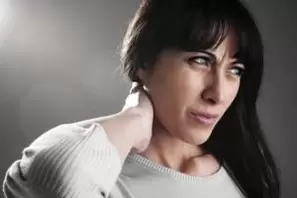
The cervical spine is one of the most vulnerable to osteochondrosis and, unfortunately, is very often affected by this disease. Its symptoms, in addition to the pain in the neck itself, can be intense headaches associated with the capture of the vertebral artery by bony outgrowths of the vertebrae. Cervical osteochondrosis can be dangerous not only for the elderly, but also for young people who lead a sedentary and sedentary lifestyle.
What are the causes of cervical osteochondrosis?
The causes of cervical osteochondrosis are the same as those of the entire degenerative process of the spine as a whole: lack of physical activity, malnutrition, heredity, sedentary work, occupational overload and others. Of the special factors should be noted the high mobility of this part of the spine, due to which the cervical vertebrae have a large daily load.
Many features of cervical osteochondrosis are also related to the fact that the cervical vertebrae differ in structure from the others and are closely related to the important blood vessels of the neck that feed the brain. These vessels are called vertebral arteries or simply vertebral arteries. They pass inside the arches of the cervical vertebrae, delivering blood directly to the cranial cavity. And if the cervical vertebra is affected by osteochondrosis, then the artery inside the vertebra can be compressed, which reduces blood flow to the brain. This is one of the mechanisms for the occurrence of headaches in cervical osteochondrosis.
What are the stages of cervical osteochondrosis?
Osteochondrosis of the cervical spine can be mild or severe. The most severe stage of degeneration is an intervertebral hernia. Hernias do not occur as often in the cervical region as in the lumbar region, but even here they are not uncommon. Many young people come to the doctor with hernias detected by MRI, while others have hernias during the diagnostic process. The important thing here is that the hernia itself is not always the cause of pain, but this does not mean that it should not be treated.
It is important to note that not all neck pain is caused by osteochondrosis. That is, this process can take place, but it is not the cause of this pain syndrome in this patient. Much more often the cause of pain is musculoskeletal syndrome, the essence of which is the overexertion of short sections of skeletal muscle. For example, if we sit in front of a computer for a long time, the trapezius muscles tingle in a monotonous position, which leads to their spasm and pain, which can radiate to the neck, head and arms.
How to treat cervical osteochondrosis?

Several key points need to be considered for the proper and competent treatment of cervical osteochondrosis. They are all related in some way to prevention and early visits to the doctor. We list the most necessary measures:
- Carefully follow the rules of ergonomics, organization of your workspace, the correct height of the table, the monitor at eye level.
- Regular warming of the neck and arms (which are closely related to it), at least once every 1, 5-2 hours during sedentary work, daily morning exercises.
- Regular courses of massage and osteopathy, at least once every 6 months.
Taking painkillers can begin only on the instructions of a doctor, otherwise you can just drive the disease into a corner, relieving symptoms and leaving the cause of the pathology unattended.
How can osteopathy help with cervical osteochondrosis?
Osteopathy for this disease is a very effective method of treatment. The fact is that the need for manual procedures for osteochondrosis is obvious to everyone, but not everyone understands how dangerous these manipulations can be.
Some chiropractors practice harsh techniques of trust, after which the patient suddenly feels particularly "positive", achieving "enlightenment" in the head. This is the "reduction" of the vertebrae with incredible crunch and terrible, suffocating, suffocating techniques for unlocking motor segments.
It must be said that all these rough and outwardly beautiful techniques are often dangerous and have nothing to do with osteopathy. The system of the cervical vertebrae is arranged very finely and balanced, so that any rough intervention affects not only one vertebra, but also the whole neck, the whole spine, the head, the blood vessels, and so on.
The osteopath works with the neck very carefully and smoothly, without rough movements and sharp manipulations. At first glance, it may seem that the doctor did nothing special, but this is not the case. The basis of osteopathy is the fine sensitivity of the doctor's hands. The osteopath always knows how to balance the system of muscles, ligaments and bones without harming it. Therefore, osteopathic correction of cervical osteochondrosis is the most successful, safe and effective.



















